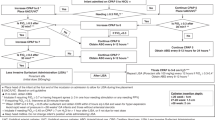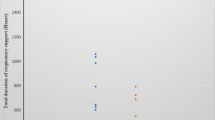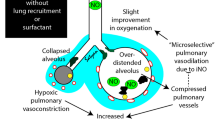Abstract
The use of mechanical ventilation in premature infants with respiratory distress syndrome (RDS) and respiratory failure often results in barotrauma, volutrauma and chronic lung disease (CLD). Research indicates that early surfactant therapy and initiation of nasal continuous positive airway pressure (CPAP) for these infants significantly reduces the need for mechanical ventilation and the incidence of CLD. Different CPAP delivery systems exist, each with some practical and clinical advantages and disadvantages. Clinical trials indicate that optimal management of neonatal RDS could be improved by early surfactant treatment followed immediately by extubation and stabilization on CPAP. Evidence suggests a synergistic effect between early surfactant administration (within 2 h of birth) and rapid extubation to nasal CPAP with a significant reduction in the need for mechanical ventilation and its associated morbidities.
This is a preview of subscription content, access via your institution
Access options
Subscribe to this journal
Receive 12 print issues and online access
$259.00 per year
only $21.58 per issue
Buy this article
- Purchase on Springer Link
- Instant access to full article PDF
Prices may be subject to local taxes which are calculated during checkout

Similar content being viewed by others
References
Stevens TP, Blennow M, Soll RF . Early surfactant administration with brief ventilation vs selective surfactant and continued mechanical ventilation for preterm infants with or at risk for respiratory distress syndrome. Cochrane Database Syst Rev 2004; (3), Art. No.: CD003063. DOI: 10.1002/14651858.CD003063.pub2.
Ramanathan R, Sekar K, Soll RF, Wung JT . Expert opinions in managing neonatal respiratory distress syndrome: focus on noninvasive ventilation strategies. {Pamphlet}. Publisher: Annenberg Center For Health Sciences at Eisenhower. Available at www.5starmeded.org/shared/4399.pdf (accessed 2006 September 4) 2005.
Coalson JJ . Pathology of new bronchopulmonary dysplasia. Semin Neonatol 2003; 8: 73–81.
Van Marter LJ, Allred EN, Pagano M, Sanocka RP, Parad R, Moore M et al. Do clinical markers of barotrauma and oxygen toxicity explain interhospital variation in rates of chronic lung disease? Pediatrics 2000; 105: 1194–1201.
Whitehead T, Slutsky AS . The pulmonary physician in critical care-7. Ventilator induced lung injury. Thorax 2002; 57: 635–642.
Robinson MJ, Maayan C, Eyal FG, Armon Y, Bar-Yishay E, Godfrey S . Does the pattern of ventilation determine the degree of lung damage following intensive care of the newborn? Isr J Med Sci 1982; 18: 835–839.
Speer CP . Inflammation and bronchopulmonary dysplasia. Semin Neonatol 2003; 8: 29–38.
Jobe AH, Kramer BW, Moss TJ, Newnham JP, Ikegami M . Decreased indicators of lung injury with continuous positive expiratory pressure in preterm lams. Pediatr Res 2002; 52: 387–392.
Latini G, De Felice C, Presta G, Rosati E, Vacca P . Minimal handling and bronchopulmonary dysplasia in extremely low-birth-weight infants. Eur J Pediatr 2003; 162: 227–229.
Castillo A, Sola A, Baquero H, Neira F, Alvis R, Deulofeur R et al. Pulse oxygen saturation levels and arterial oxygen tension values in newborns receiving oxygen therapy in the neonatal intensive are unit: Is 85% to 93% an acceptable range? Pediatrics 2008; 121: 882–889.
Gal P, Shaffer CL . Acute respiratory distress syndrome In: DiPiro JT, Talbert RL, Yee GC (eds). Pharmacotherapy: A Pathophysiologic Approach. 5th edn. McGraw-Hill: New York, 2002, pp 531–538.
Gregory GA, Kitterman JA, Phibbs RH, Tooley WH, Hamilton WK . Treatment of the idiopathic respiratory-distress syndrome with continuous positive airway pressure. N Engl J Med 1971; 284: 1333–1340.
Dunn PM, Thearle MJ, Parsons AC, Watts JL . Use of the ‘Gregory box’ (CPAP) in treatment of RDS of the newborn: preliminary report. Arch Dis Child 1972; 47: 674–675.
Kirby R, Robison E, Schulz J, DeLemos RA . Continuous-flow ventilation as an alternative to assisted or controlled ventilation in infants. Anesth Analg 1972; 51: 871–875.
Mulrooney N, Champion Z, Moss TJ, Nitsos I, Ikegami M, Jobe AH . Surfactant and physiologic responses of preterm lambs to continuous positive airway pressure. Am J Respir Crit Care Med 2005; 171: 488–493.
Aly HZ . Nasal prongs continuous positive airway pressure: a simple yet powerful tool. Pediatrics 2001; 108: 759–761.
DePaoli AG, Davis PG, Faber B, Morley CJ . Devices and pressure sources for administration of nasal continuous positive airway pressure (NCPAP) in preterm neonates. Cochrane Database Syst Rev 2002; (4), Art. No.: CD002977.
Kahn DJ, Courtney SE, Steele AM, Habib RH . Unpredictability of delivered bubble nasal continuous positive airway pressure; role of bias flow magnitude and nares-prong air leaks. Pediatr Res 2007; 62: 343–347.
Polin RA, Sahni R . Continuous positive airway pressure: Old questions and new controversies. J Neonatal Perinat Med 2008; 1: 1–10.
Pandit PB, Courtney SE, Pyon KH, Saslow JG, Habib RH . Work of breathing during constant- and variable-flow nasal continuous positive airway pressure in preterm neonates. Pediatrics 2001; 108: 682–685.
Blennow M, Jonsson B, Dahlstrom A, Sarman I, Bohlin K, Robertson B . Lung function in premature infants can be improved. Surfactant therapy and CPAP reduce the need of respiratory support. Lakartidningen 1999; 96: 1571–1576.
Verder H, Robertson B, Greisen G, Ebbesen F, Albertsen P, Lundstrom K et al. Surfactant therapy and nasal continuous positive airway pressure for newborns with respiratory distress syndrome. N Engl J Med 1994; 331: 1051–1055.
Verder H, Albertsen P, Ebbesen F, Greisen G, Robertson B, Bertelsen A et al. Nasal continuous positive airway pressure and early surfactant therapy for respiratory distress syndrome in newborns of less than 30 weeks' gestation. Pediatrics 1999; 103: E24.
Reininger A, Khala R, Kendig JW, Ryan RM, Stevens TP, Reubens L et al. Surfactant administration by transient intubation in infants 29 to 35 weeks' gestation with respiratory distress syndrome decreases the likelihood of later mechanical ventilation: a randomized controlled trial. J Perinatol 2005; 25: 703–708.
Dani C, Bertini G, Pezzati M, Cecchi A, Caviglioli C, Rubaltelli FF . Early extubation and nasal continuous positive airway pressure after surfactant treatment for respiratory distress syndrome among preterm infants <30 weeks' gestation. Pediatrics 2004; 113: e560–e563.
Haberman B, Shankaran S, Stevenson DK, Papile LA, Stark A, Korones S et al. Does surfactant and immediate extubation to nasal continuous positive airway pressure reduce use of mechanical ventilation? Pediatr Res 2002; 51: 349A.
Tooley J, Dyke M . Randomized study of nasal continuous positive airway pressure in the preterm infant with respiratory distress syndrome. Acta Paediatr 2003; 92 (10): 1170–1174.
Soll RF, Conner JM, Howard D, the Investigators of the Early Surfactant Replacement Study. Early surfactant replacement in spontaneously breathing premature infants with RDS. http://www.pas-meeting.org/2003Seattle/Abstracts/LBFullAbs.htm. PAS2003: LB12.
Texas Neonatal Research Group. Early surfactant for mild to moderate RDS. J Pediatr 1004; 114: 804–808.
Sandri F, Ancora G, Lanzoni A, Tagliabue P, Colnaghi M, Ventura ML et al. Prophylactic nasal continuous positive airway pressure in newborns of 28-31 weeks gestation; multicentre randomized controlled clinical trial. Arch Dis Child Fetal Neonatal Ed 2004; 89: 394–398.
Stevens TI, Blennow M, Soll RF . Early surfactant administration with brief ventilation vs selective surfactant and continued mechanical ventilation for preterm infants with or at risk for respiratory distress syndrome. Cochrane Database Syst Rev 2007; (2), Art. No.: CD 003063. DOI:10.1002/14651858. CD003063.pub3.
Booth C, Premkumar MH, Yannoulis A, Thomson M, Harrison M, Edwards AD . Sustainable use of continuous positive airway pressure in extremely preterm infants during the first week after delivery. Arch Dis Child Fetal Neonatal Ed 2006; 91: 398–402.
Ammari A, Suri M, Milisavljevic V, Sahni R, Bateman D, Sanocka U et al. Variables associated with the early failure of nasal CPAP in very low birth weight infants. J Pediatr 2005; 147: 341–347.
Ehrenkranz RA, Walsh MC, Vohr BR, Jobe AH, Wright LL, Fanaroff AA et al. Validation of the National Institutes of Health Consensus Definition of Bronchopulmonary Dysplasia. Pediatrics 2005; 116: 1353–1360.
Narendran V, Donovan EF, Hoath SB, Akinbi HT, Steichen JJ, Jobe AH . Early bubble CPAP and outcomes in ELBW preterm infants. J Perinatol 2003; 23: 195–199.
Finer NN, Carlo WA, Duara S, Fanaroff AA, Donovan EF, Wright LL et al. Delivery room continuous positive airway pressure/positive end-expiratory pressure in extremely low birth weight infants: a feasibility trial. Pediatrics 2004; 114: 651–657.
Aly H, Milner JD, Patel K, El-Mohandes AA . Does the experience with the use of nasal continuous positive airway pressure improve over time in extremely low birth weight infants? Pediatrics 2004; 114: 697–702.
Morley CJ, Davis PG, Doyle LW, Brion LP, Hascoet JM, Carlin JB . Nasal CPAP or intubation at birth for very preterm infants. N Engl J Med 2008; 358 (7): 700–708.
Adamkin DH . Pragmatic approach to in-hospital nutrition in high-risk neonates. J Perinatol 2005; 25: S7–S11.
Sekar KC . The role of continuous positive airway pressure therapy in the management of respiratory distress in extremely premature infants. J Pediatr Pharmacol Ther 2006; 11: 145–152.
Author information
Authors and Affiliations
Corresponding author
Rights and permissions
About this article
Cite this article
Sekar, K., Corff, K. To tube or not to tube babies with respiratory distress syndrome. J Perinatol 29 (Suppl 2), S68–S72 (2009). https://doi.org/10.1038/jp.2009.28
Published:
Issue Date:
DOI: https://doi.org/10.1038/jp.2009.28
Keywords
This article is cited by
-
Influence of time under mechanical ventilation on bronchopulmonary dysplasia severity in extremely preterm infants: a pilot study
BMC Pediatrics (2020)
-
Trends in survival among extremely-low-birth-weight infants (less than 1000 g) without significant bronchopulmonary dysplasia
BMC Pediatrics (2012)
-
Iatrogenic complications in the neonatal intensive care unit
Journal of Perinatology (2010)



